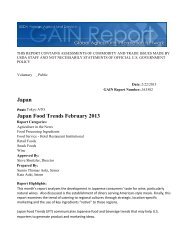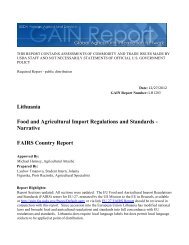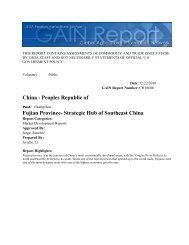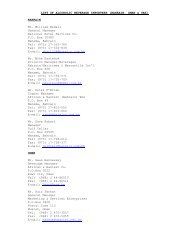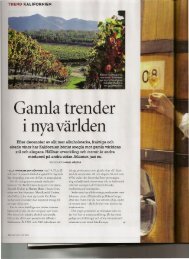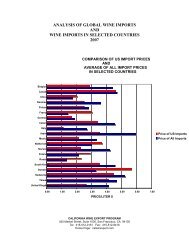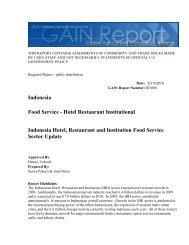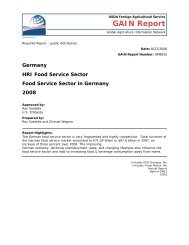Brazil Wine Market Report JBC EMP July 2011 - California Wine ...
Brazil Wine Market Report JBC EMP July 2011 - California Wine ...
Brazil Wine Market Report JBC EMP July 2011 - California Wine ...
You also want an ePaper? Increase the reach of your titles
YUMPU automatically turns print PDFs into web optimized ePapers that Google loves.
Domestic <strong>Market</strong>ing<br />
16<br />
<strong>Brazil</strong>ian <strong>Wine</strong> <strong>Market</strong> <strong>Report</strong><br />
In 2008, IBRAVIN (<strong>Brazil</strong>ian Institute of <strong>Wine</strong>) and key players of the wine industry<br />
invested in an advertising campaign to promote national brands of still light grape wines<br />
and highlight the high quality of <strong>Brazil</strong>ian wines. There are also efforts to increase exports of<br />
still light grape wines and sparkling wines through a project called “<strong>Wine</strong>s of <strong>Brazil</strong>”, a<br />
partnership between wine manufacturers and APEX (<strong>Brazil</strong>ian Agency of Promotion of<br />
Exports and Investments). Sparkling wines still account for the majority of exports reaching<br />
665 tonnes in 2007.<br />
Declining sales of table wines and competition with Chilean and Argentinean still light grape<br />
wines will lead domestic manufacturers to increase investment in a wide product portfolio of<br />
fine wines with brands positioned as low-, mid- and high-end as part of the strategy to<br />
remain competitive and cater to the different demands of high-income consumers and mid-<br />
/low-income consumers. For wealthier consumers, the grape varietal type and origin of the<br />
wine are important attributes, while price followed by origin are the most important criteria<br />
for lower-income brackets.<br />
The competition between imported and national wines will persist until the <strong>Brazil</strong>ian<br />
government, trade associations and key domestic manufacturers adopt an agreement about<br />
the import tax charged to Chilean and Argentinean governments or subsidies provided by<br />
the <strong>Brazil</strong>ian government to protect domestic companies. Meanwhile, the wine industry will<br />
have to maintain investments in economy products and/or marketing campaigns to increase<br />
the visibility of their products.<br />
Investment in smaller packaging for sparkling wines and still light grape wines such as Salton<br />
might be a good strategy to stimulate young consumers to trial different alcoholic beverages,<br />
especially in the on-trade since the sector faces resistance from consumers between the ages<br />
of 18 and 25 that frequently prefer beverages such as beer, vodka and RTDs.<br />
U.S. <strong>Wine</strong>s in <strong>Brazil</strong><br />
Current U.S. Exports<br />
In 2010, U.S. wine sales to <strong>Brazil</strong> totaled $1,415,977 8 ; however, this represented a<br />
miniscule percentage of the wine import market. Over the last three years, <strong>Brazil</strong> has<br />
imported approximately 6.5 million cases (12 bottles of 750ml each) of wine per year, which<br />
represents US$ 196 million FOB of annual imports. The U.S. share of those imports is less<br />
than one percent. Although <strong>Brazil</strong>’s population is approximately 203 million, wine<br />
consumption per capita for 2010 was 1.8 liters. This small figure presents definite<br />
possibilities for market expansion. The United States Department of Agriculture, Foreign<br />
Agricultural Service (FAS) prepared a list of best import prospects based on <strong>Brazil</strong>ian<br />
consumption patterns. According to the FAS market trend evaluation, wine ranks second on<br />
the list of potential increase.<br />
8 http://www.gtis.com/gta/secure/gateway.cfm



